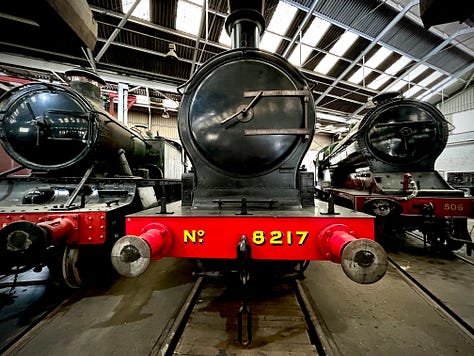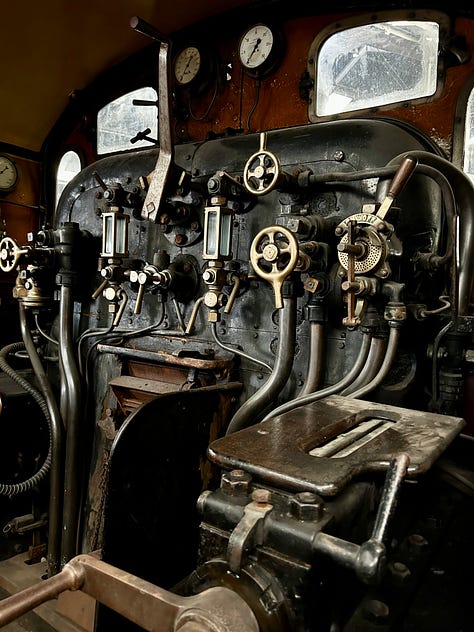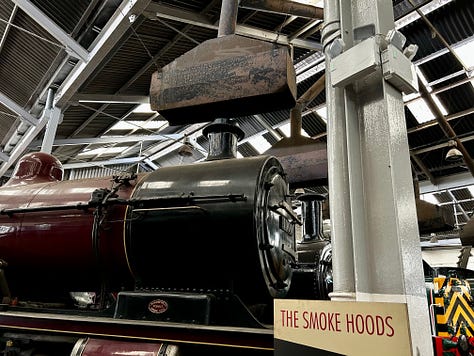Today I am visiting Barrow Hill Roundhouse, which is close to the Derbyshire towns of Staveley and Chesterfield. Railways should be in my blood as my grandfather, Joseph Millward, was a steam engine driver based at Staveley, as was my great-grandfather. Grandad Joe retired at age 65 in the early 1960s.
It was good to visit a place he would have driven his train to during his career on the railway and to take his great-great-grandson, Albie, with me, aged two.
Barrow Hill - the last surviving roundhouse
Barrow Hill is the last surviving roundhouse. To clarify, a roundhouse is a turntable, storage, and servicing area for locomotives. The building of Barrow Hill commenced in July 1869 and was completed in November 1870. British Rail decided that its time of usefulness had been reached and to close it in 1991. The plan had been to demolish the building and lift the tracks.
Click on any photo to see in full size
With great foresight, Mervyn Allcock, at just 22 years of age, formed the Barrow Hill Engine Shed Action Group. With his hard work and other group members, the local authority was persuaded to list the building preventing it from being demolished. Thus in February 1991, it was granted Grade 2 listed status.
It wasn’t all plain sailing, however. It took a while before the group could gain control of the roundhouse, and during that period, the buildings were vandalised and some of the tracks stolen. The volunteers succeeded with genuine love and enthusiasm for the roundhouse, and Barrow Hill Roundhouse was reopened in July 1998.
Arriving at the Roundhouse, you will be greeted by a volunteer and for just £8 for an adult (2023), you can enjoy looking around this railway time capsule. As a note, there is plenty of free car parking on site. You can also access the cafe without visiting the Roundhouse, so if you’re in the area, it’s a nice place to stop for a drink and a bite to eat.


We start our journey by passing through the period-furnished office and museum displays. Albie was impressed with the models of trains made out of paper on display along with other items of railwayana. Next, we are in the roundhouse, where the all-important turntable lies in the centre of the building. The turntable is rotated several times daily for visitors to see it in action.
There are a few minutes before it is due to turn at 1 pm, so we take advantage to wander around the mixture of steam and diesel locos on the ‘roads’ off the turntable. These are giant beasts, and Albie is unsure about standing by them. A locomotive viewed from the ground and not platform level and up so close is a sight to behold. None of the trains is fired up; it wouldn’t be safe for visitors for them to be.






Locomotives are also restored here, and there is the sound of hammers trying to loosen up nuts echoing around the building. In spaces like this, the sound is amplified, and I try to imagine what it would have been like years ago. The steam and noise would have been incredible. The smoke from the funnels of the steam engines would have been captured by the vents hanging over them. I expect there was plenty of soot in the air, and workers came home grimy with that and the oil and grease from working on the locos. If anyone has experience of those times, please leave a comment.
It’s now time for the turntable demonstration.
On the turntable is D2869, a Class 02 diesel loco built in 1969. You can watch the turntable in action in the video below and hear about it during the demonstration.
Barrow Hill Roundhouse has a commercial side, and the man behind saving the roundhouse, Mervyn Allcock, oversees. The money generated from this helps to fund the excellent preservation and educational work Barrow Hill Roundhouse does.
Leaving the roundhouse, we walk across to look at the Deltic Shed. This is the home of The Deltic Preservation Society. Here we see Deltic diesel locos in various states of preservation. Seeing an engine out of a train shows just how huge it is. I climb into a cab set up for visitors, but Albie gets worried. He seems concerned that Grandad will drive off, and he refuses to come inside.
If you are interested in the Deltic class of locomotives and their preservation, visit the Deltic Preservation Society website.



My next stop is the Coaling Stage. This is where coal was loaded into the tenders of steam locomotives to power them on their journeys. This was hard work as coal had to be unloaded by hand from wagons and put into wheeled tubs. The coal in the tubs was then tipped into the tenders waiting below.
A little further down the track is the signal box, which is also demonstrated, but I didn’t manage to attend that.
Here’s a little more history about Barrow Hill Roundhouse
In 1841 the North Midland Railway reached Staveley and opened a station at Barrow Hill on April 6th of that year. This station was closed on November 15th 1888, and with the opening of the Clowne and Mansfield branch line, a new station opened on the same date. The new station was named Barrow Hill and Staveley Works. In 1866 the Midland Railway entered an agreement with Staveley Works. They purchased and operated the private works railway for 100 years.
The railway shed built near the station in 1865 became too small, which led to the building of the roundhouse. The cost of construction came to £16,445 4s 9d. I love the accuracy of accounting in those days. None of this £1.2 billion! There’s a lot of scope in that.
The roundhouse comprises 24 roads, the longest eighty feet and the shortest 60 feet. It is therefore designed to house 24 locomotives. During the 1920s, the allocation reached 90 locos. By the 1940/50s, this was down to 75 and was reduced to 30 before steam trains were retired from service on October 4th 1965. In 1983 there were just five diesel shunters and in 1987 only three. By 1988 Barrow Hill had become a stabling and signing-on point for loco crews on coal traffic workings.
Britain once had a very extensive railway network. With time, much of it has disappeared, some due to the closing of industry and others the lack of use. During the 1960s, many lines were closed in what is known as the Beeching Axe, named after Richard Beeching, at the time the chairman of British Railways.
Take a look at the screenshot from Railmap Online. All the tracks in yellow were once operational. Much of the area around Barrow Hill was the tracks of Staveley Iron and Chemical Works. As you walk along roads in Britain, you are bound to see manhole covers stamped “Stanton & Staveley. These have been made at Staveley Works, which by 2007, most of the former works had been shut down and the site cleared.

Thankfully, we can visit the Barrow Hill Roundhouse, a place built for the steam railways when locomotives needed to be turned, unlike modern trains that have a cab at each end. The volunteers do an excellent job.
Finally, we popped into the shop, followed by the cafe. Albie chose a pack of six trains at only £3, and all the goods on sale seemed to be at genuine prices. That can’t be said for all museums! A nice touch in the cafe - if you have tea or coffee, it comes in a real mug!
Barrow Hill Roundhouse is certainly a place worth visiting, and they do have special events; a visit to the website will tell you more about those.
Thank you for reading, and please do leave a comment. If you’re not a subscriber, please consider adding your email address in the box below. You won’t be spammed.








Thank you, Roland I love steam engines (who doesn’t) and your photos are great.